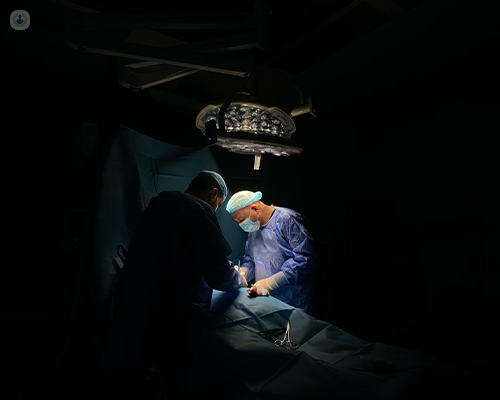Gynaecological laparoscopic surgery in detail
Escrito por:The prospect of having gynaecological laparoscopic surgery invites various considerations, such as how it's performed, which specific conditions are treated and many more.
Leading consultant gynaecologist Mr Angus J.M. Thomson is here to provide an expert, in-depth look at this topic. Read on to find out more in this comprehensive article.

What is gynaecological laparoscopic surgery and how is it performed?
Gynaecological laparoscopic surgery is effectively keyhole surgery used for any gynaecological procedure.
Nowadays, the majority of gynaecological procedures can be performed laparoscopically by trained clinicians.
Laparoscopic surgery gives the advantage of better access, better magnification and better visualisation of all the structures within the pelvis, so that the surgery can be performed more accurately and with less risk of damaging other structures. It has the advantage that it can be done through small incisions rather than large, open incisions.
What are the most common gynaecological conditions treated with laparoscopic surgery?
Most conditions within gynaecology can be treated with laparoscopic surgery. The ones that are commonly treated this way, are treatment of:
- endometriosis, or pelvic pain;
- treatments for heavy periods such as hysterectomy or removal of fibroids;
- fertility treatments, either to improve fertility or to perform procedures such as egg collection and IVF, can be performed laparoscopically.
Also, increasingly, treatments for urogynaecology such as prolapse repairs or incontinence surgery can also be performed by laparoscopic surgery. Any gynaecologist doing cancer care also use laparoscopic surgery for diagnosis and treatment of cancer, but not all cancer surgery is done by keyhole surgery.
What are the advantages of gynaecological laparoscopic surgery over traditional open surgery?
The advantages I mentioned at the beginning were the advantages to the operator because they can actually see better, they've got better magnification, better visualisation. From a patient point of view, the advantages are:
- less pain;
- quicker recovery;
- shorter hospital stay.
Therefore, a quicker return to normal activities and also a quicker return to work.
What are the potential risks and complications associated with gynaecological laparoscopic surgery?
The complications of laparoscopic surgery are the same as for other types of surgery, such as open surgery or vaginal surgery with routine complications such as:
- bleeding;
- bruising;
- infection;
- discomfort.
However, with laparoscopic surgery we also warn that for all women, there's a chance we can damage tissues close to where we're operating. You get the same risk of damage in open surgery, but with laparoscopic surgery we have to take particular care not to damage the organs close by such as bladder, bowel, blood vessels.
Overall, laparoscopic surgery is far safer than open surgery because the risk of complications, both during the operation but also afterwards are lower than keyhole surgery than they are with open surgery.
How can patients prepare for gynaecological laparoscopic surgery, and what is the average recovery period?
Preparation for laparoscopic surgery is very much the same as preparation for other surgeries. It's about being as healthy as you can be. You want to be fit, healthy, slim and non-smoking. Have a good exercise regime, have a good diet, make sure that your bowels are working properly and that you aren't constipated. All these things make any surgery, but also particularly laparoscopic surgery, safer and more effective.
In terms of typical recovery, it rather depends of the type of operation we're performing. Generally, after smaller laparoscopic surgery, one would expect to be back to normal activities and back to work within one to two weeks. With more intermediate and larger operations such as hysterectomy, I normally recommend that people have four weeks off work. Although many will be back to driving before that time.
When we come to urogynaecology procedures for pelvic floor or incontinence, the length of recovery isn't so much down to how well you feel. It's more down to the rest that we want for you to take, to stop complications coming back. So, for example, if you're treating prolapse, whether it's open or laparoscopic, or vaginal surgery, we like people to have eight weeks recovery afterwards so they're not doing lifting, they're not over exerting and they're not causing the problem to likely return. For prolapse surgery, even if it's laparoscopic, we still recommend eight weeks recovery. Mostly, laparoscopic surgery will give much quicker recovery than open surgery.
If you require expert gynaecological laparoscopic surgery, arrange a consultation with Mr Thompson via his Top Doctors profile.


